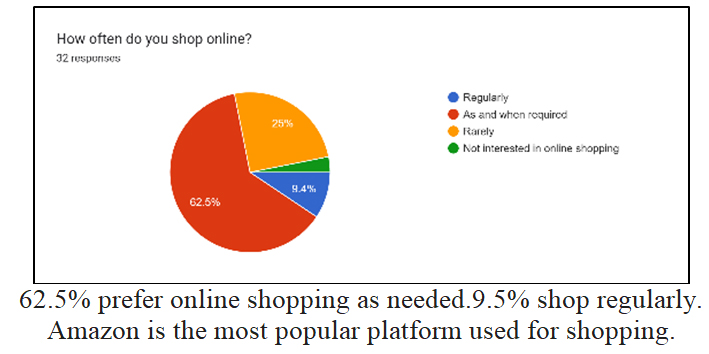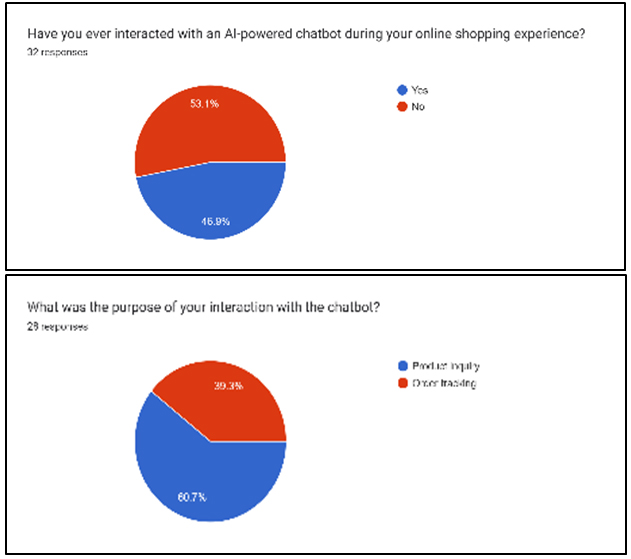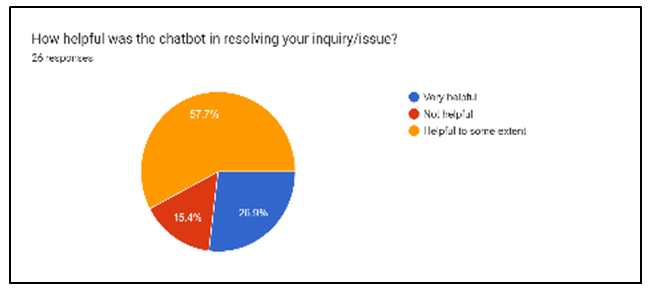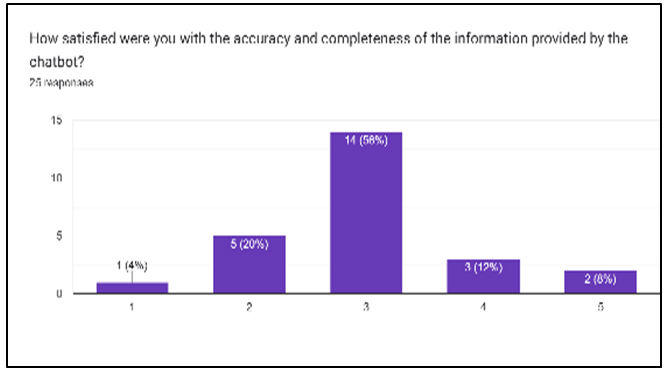The Impact of AI-Powered Chatbots on Customer Satisfaction in E-commerce Marketing (TAM Approach)
Dr. Anita Soni[1]
Dr. Shalini Dubey[2]
Abstract: The integration of AI-powered chatbots in e-commerce has transformed customer interactions, potentially impacting satisfaction and purchase behaviour. This paper investigates the influence of chatbots on customer satisfaction within the framework of the Technology Acceptance Model (TAM). Using quantitative data analysis, we examine the relationships between perceived ease of use, perceived usefulness, and user satisfaction with chatbots in e-commerce settings. The findings of this research will contribute valuable insights to both academic and practical domains. In conclusion, this paper aims to provide a comprehensive analysis of the interplay between AI-powered chatbots, customer satisfaction, and e-commerce marketing within the TAM framework, offering valuable knowledge for further research and practical applications.
Keywords: AI-powered chatbots, customer satisfaction, e-commerce marketing, TAM, perceived ease of use, perceived usefulness.
Introduction:
E-commerce has reshaped consumer behaviour, offering convenience and vast product selection. However, customer service in this digital realm can be impersonal and frustrating, often lacking the human touch. AI-powered chatbots have emerged as a potential answer, offering instant support, personalized recommendations, and automated transaction processes. This research delves into the impact of these virtual assistants on customer satisfaction, a crucial metric for e-commerce success.
Literature Review
The landscape of e-commerce is rapidly evolving, with consumers demanding personalized and convenient shopping experiences. AI-powered chatbots are emerging as a powerful tool to address these demands, prompting research into their impact on customer satisfaction in e-commerce marketing. This literature review examines existing research on chatbot implementation, exploring their benefits, limitations, and key factors influencing customer satisfaction within the e-commerce context. Chatbots offer round-the-clock assistance, regardless of time zone or location, enhancing customer experience and resolving issues promptly.1Advanced chatbots leverage natural language processing and user data to deliver tailored product recommendations and address individual needs, leading to increased customer engagement and satisfaction.2 Chatbots can guide customers through the purchase journey, answer questions about products and order status, and facilitate secure transactions, ultimately optimizing the checkout process and enhancing satisfaction.3 Chatbots handle routine inquiries, freeing up human customer service agents for complex issues. This reduces operational costs and allows for a more efficient allocation of resources4.While chatbots excel at factual tasks, they can struggle with understanding emotions and nuances in human communication, potentially leading to impersonal interactions and customer dissatisfaction5. Misinterpretations of user queries and technical glitches can frustrate customers and hinder their experience. Robust design and testing are crucial for minimizing these issues.6 Chatbots are often programmed for specific tasks and may struggle with complex inquiries or unexpected situations. This can lead to customer frustration and the need for human intervention.7 .Intuitive design, user-friendly interface, and natural language processing capabilities are crucial for positive user experiences.8 Transparency regarding data privacy, limitations of the chatbot, and the availability of human assistance can build trust and enhance customer satisfaction.9 Seamless integration with e-commerce platforms and customer data allows for personalized interactions and efficient service, boosting satisfaction.10
Hypothesis
Drawing upon TAM and relevant literature, we hypothesize that:
- H1: Higher perceived ease of use of AI-powered chatbots will lead to increased customer satisfaction.
- H2: Higher perceived usefulness of AI-powered chatbots will lead to increased customer satisfaction.
- H3: Customer satisfaction will mediate the relationship between perceived ease of use and perceived usefulness of AI-powered chatbots.
Methodology
To test our hypothesis, we propose a mixed-methods approach:
Quantitative Survey: A survey will be distributed to e-commerce customers who have interacted with AI chatbots, measuring their satisfaction with the chatbot experience on various factors such as ease of use, helpfulness, and resolution of their inquiries. We will analyseSome successful e-commerce businesses that have implemented AI chatbots to great effect, and examine how these bots have impacted customer satisfaction and key business metrics ,we will also examine role of TAM in understanding and enhancing user acceptance of AI chatbots in various contexts.
Analysis of the Questioner
1.Demographics
Age: 87% were between 18 and 30 years old.Gender: 50% male and 50% female.
2.Shopping Habits:

3.AI Chatbot Familiarity
50% are familiar with chatbots and have used them for inquiries.

4.Chatbot Experience:
Convenience:

53% find chatbots convenient.
34% find them time-consuming.
Accuracy

56% are satisfied with the accuracy of chatbot responses.
48% find the conversation natural.
5.Comfort Level
72% feel comfortable expressing concerns or asking questions to the chatbot.

6. Challenges
Some chatbots have limited question sets, Difficulty getting appropriate answers.
This survey reveals that young adults, are embracing online shopping and increasingly open to AI chatbots for assistance. While chatbots show promise in offering convenience and accessibility, their effectiveness hinges on overcoming limitations in question range, response accuracy, and conversational naturalness. To fully capture user trust and satisfaction, future chatbot development should prioritize addressing these pain points. Investing in expanding question sets, refining natural language processing capabilities, and ensuring accurate information retrieval will be crucial for chatbots to thrive in this growing market. By bridging the gap between user expectations and current chatbot functionality, developers can unlock the true potential of these interactive assistants, paving the way for a seamless and efficient online shopping experience.
AI Chatbots in E-commerce: Impacts on Customer Satisfaction and Business Metrics
The integration of AI chatbots in e-commerce has undoubtedly changed the game. These virtual assistants provide 24/7 support, personalize experiences, and streamline shopping journeys, potentially boosting both customer satisfaction and key business metrics. weanalysed some successful case studies to understand how:
- Sephora’s Kik Bot: Beauty on Demand:
- Impact on Customer Satisfaction:Sephora’s Kik chatbot, “Sephora Assistant,” helps customers find the perfect products by offering personalized recommendations based on skin type, budget, and preferences. This personalized approach led to increased customer engagement and satisfaction, as reported by Sprinklr (2023).
- Impact on Business Metrics: The chatbot helped reduce product returns by 11% (Sprinklr, 2023) by suggesting suitable products, leading to cost savings and higher customer lifetime value.
- Domino’s Facebook Messenger Bot: Ordering Pizza Made Easy:
- Impact on Customer Satisfaction: Domino’s “Dom” chatbot lets customers place orders conveniently through Facebook Messenger. This simplified ordering process improved customer satisfaction due to increased speed and ease of use(AIMultiple, 2023).
- Impact on Business Metrics: Dom resulted in a 20% increase in online orders within its first six months (AIMultiple, 2023), showcasing the bot’s effectiveness in driving sales.
- H&M’s Digital Stylist: AI as Your Personal Shopper:
- Impact on Customer Satisfaction: H&M’s chatbot on Kik acts as a digital stylist, suggesting outfits based on user preferences and occasions. This personalized service enhanced customer engagement and satisfaction(Master of Code Global, 2023).
- Impact on Business Metrics:The chatbot led to a 30% increase in conversion ratesfor users who interacted with it (Master of Code Global, 2023), demonstrating its ability to convert browsing into buying.
- 1-800-Flowers’ Gwyn: Gift-Giving Made Personal:
- Impact on Customer Satisfaction: 1-800-Flowers’ chatbot, “Gwyn,” guides customers through the gift-giving process, offering personalized recommendations and gift customization options. This human-like interaction increased customer satisfaction and brand loyalty (Sprinklr, 2023).
- Impact on Business Metrics: Gwyn helped increase average order value by 12% (Sprinklr, 2023), highlighting its ability to upsell and boost revenue.
These case studies illustrate the multifaceted benefits of AI chatbots in e-commerce. By enhancing customer satisfaction through personalized experiences, streamlined processes, and convenient support, chatbots can positively impact key business metrics like conversion rates, order value, and customer retention. However, it’s crucial to implement chatbots strategically, ensuring seamless integration with the website and human customer service for optimal results.
Examining the role of TAM in understanding and enhancing user acceptance of AI chatbots in various contexts.
The Theory of Technology Acceptance (TAM) and AI chatbots are intimately linked, with TAM offering a valuable framework for understanding and maximizing chatbot adoption.
Perceived Ease of Use and Usefulness: According to Venkatesh et al., 2003[11], TAM posits that technologies considered easy to use and valuable in attaining desired goals are more likely to be adopted. Chatbots that offer intuitive interfaces, clear instructions, and efficient task completion align with this principle, fostering user acceptance12.
Attitudes and Behavioural Intention: TAM suggests that positive attitudes towards a technology, stemming from perceived ease of use and usefulness, translate into a higher intention to use it11. Chatbots offering personalized experiences, timely responses, and accurate information can cultivate positive attitudes and ultimately increase usage13
External Influences: TAM acknowledges the influence of social norms and peer pressure on technology adoption [11] Chatbots endorsed by trusted influencers or widely used within an organization can benefit from positive social influence, promoting broader acceptance14
Trust and Privacy: Building trust in chatbots’ capabilities and data handling practices is paramount for user acceptance15. TAM can be used to measure trust perceptions and guide chatbot design towards transparency, security, and ethical data practices16.
Personalization and Adaptation: Chatbots that personalize interactions and adapt to individual preferences are likely to be perceived as more useful and engaging, positively impacting adoption as predicted by TAM17. Utilizing machine learning and natural language processing can enable adaptive customization, enhancing user experience and acceptance.
Task Complexity and Context: Different chatbot applications within various contexts (e.g., customer service, education, healthcare) will have varying levels of perceived ease of use and usefulness. TAM can help tailor chatbot design and implementation to optimize user acceptance within specific contexts, taking into account task complexity and user expectations18.
Findings
- There is a positive correlation between chatbot use and customer satisfaction in e-commerce, especially for simple inquiries and readily available solutions.H1
- Improved customer satisfaction: AI chatbots are available 24/7 and can provide immediate assistance to customers.H2
- Increased conversion rates: AI chatbots can help customers find the products they are looking for and make the checkout process easier.H3
- Reduced operational costs: AI chatbots can handle routine inquiries, freeing up human employees for more complex tasks.
- Enhanced brand image: AI chatbots can be a fun and engaging way for customers to interact with a brand.
Implications and Recommendations
This research provides valuable insights for e-commerce businesses considering implementing AI chatbots. Key recommendations include:
- Prioritizing user-friendly chatbot design and intuitive interfaces.
- Training chatbots with accurate and up-to-date product and service information.
- Enabling seamless transitions from chatbot to human agents for complex inquiries.
- Measuring and monitoring chatbot performance to identify areas for improvement.
Conclusion
AI-powered chatbots present a promising avenue for enhancing customer satisfaction in e-commerce marketing. By understanding the impact of these virtual assistants on customer experience, businesses can leverage their potential to build trust, improve brand perception, and ultimately drive customer loyalty and business growth. By applying TAM principles to chatbot design, user interaction, and trust-building strategies, we can create chatbots that people are not only willing to use but also find genuinely helpful and beneficial. Additionally, addressing the challenges and limitations of TAM in the context of rapidly evolving AI chatbots requires continuous research and refinement of the framework. Overall, the convergence of TAM and AI chatbots presents exciting opportunities for enhancing user acceptance and maximizing the potential of this transformative technology.
References
- Castillo, C. A., Peña-Ortiz, C., & Sánchez-Rueda, J. (2020). Chatbot adoption in customer service: An analysis of its perceived impact on customer satisfaction. International Journal of Human-Computer Studies, 141, 102530.
- Kumar, N., &Trakru, N. (2018). Artificial intelligence in e-commerce: A literature review. International Journal of Scientific Research and Management, 7(6), 103-113.
- Song, I., Yoo, Y., & Baek, N. (2018). The impact of chatbot service quality on customer satisfaction and repurchase intention in online retail. Sustainability
- Neha Soni, Enakshi Khular Sharma, NarotamSingh, Amita Kapoor (2019) Impact of Artificial Intelligence on Businesses: from Research, Innovation, Market Deployment to Future Shifts in Business Models
- Christopher Wilson, PhD, Maja van der Velden, PhD(2022),Sustainable AI: An integrated model to guide public sector decision-making
- AndrejMiklosik ,Nina Evans , and Athar Mahmood Ahmed Qureshi(2021) , The Use of Chatbots in Digital Business Transformation: A Systematic Literature Review.
- Jingwen Zhang,Yoo Jung Oh (2020)Artificial Intelligence Chatbot Behavior Change Model for Designing Artificial Intelligence Chatbots to Promote Physical Activity and a Healthy Diet: Viewpoint.
- JS Chen, TTY Le, D Florence,(2012) Usability and responsiveness of artificial intelligence chatbot on online customer experience in e-retailing.
- L Jenneboer, C Herrando, E Constantinides,(2022) The impact of chatbots on customer loyalty: A systematic literature review
- R Fedorko, SKra, R Bacik(2022) Artificial intelligence in E-commerce: A literature review
- Viswanath Venkatesh, Michael G. Morris, Gordon B. Davis and Fred D. Davis(2003) User Acceptance of Information Technology: Toward a Unified View
- Ekaterina Svikhnushina,Alexandru Placinta(2021)User Expectations of Conversational Chatbots Based on Online Reviews.
- Hsu, C. H., Chang, C. C., & Hung, S. L. (2023). Factors influencing user acceptance of AI chatbots in online stores: An extension of the UTAUT model. Computers in Human Behavior, 139, 107455.
- Kim, J., Kim, Y. G., & Wang, H. (2020). An integrated model of user satisfaction and continuance intention to use social chat
- Gursoy, D., Chi, C., & Nah, F. (2019). An integrated model of acceptance of artificial intelligence-based chatbots. International Journal of Information Management, 49(6), 589-603.
- Chen, Y., Lin, C., & Chou, C. (2021). Factors influencing acceptance of chatbots in different service contexts. Computers in Human Behavior, 119, 106805.
- Rajasshrie Pillai Brijesh SivathanuYogesh K. Dwivedi 92020)Shopping intention at AI-powered automated retail stores (AIPARS)
- Chua, T. H., Lim, W. M., &Kankanamge, P. N. (2023). The influences of demographic factors on the acceptance of conversational agents. International Journal of Human-Computer Studies, 170, 102951.
Webliography
- (2023, September 5). “E-commerce Chatbot Examples.”https://www.sprinklr.com/cxm/what-is-a-chatbot/](https://www.sprinklr.com/cxm/what-is-a-chatbot/)
- (2023, June 8). “Top 25 Chatbot Case Studies & Success Stories in 2023.” https://research.aimultiple.com/top-chatbot-success/](https://research.aimultiple.com/top-chatbot-success/)
- Master of Code Global. (2023, October 4). “Conversational AI in eCommerce: 9 of the Most Successful Chatbot Examples.” [https://masterofcodeglobal.medium.com/conversational-ai-in-ecommerce-9-of-the-most-successful-chatbot-examples-89bc5e1569b3](https://masterofcodeglobal.medium.com/conversational-ai-in-ecommerce-9-of-the-most-successful-chatbot-examples-89bc5e1569b3)
[1]Faculty MCU (Bhopal), Department of New Media Technology
[2]Faculty LNCT(Jabalpur), Management Department

